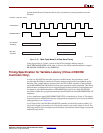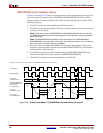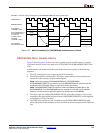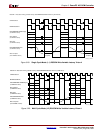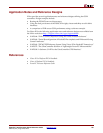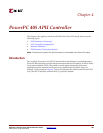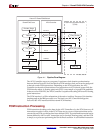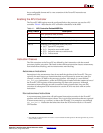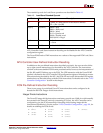
PowerPC™ 405 Processor Block Reference Guide www.xilinx.com 185
UG018 (v2.0) August 20, 2004 1-800-255-7778
R
has a configurable format and is a true extension of the PowerPC instruction set
architecture (ISA).
Enabling the APU Controller
The PowerPC MSR register must be configured before the processor can use the APU
controller. Table 4-1 describes the APU controller-related bits in the MSR.
Instruction Classes
The ISA extensions to the PowerPC are defined by their interaction with the normal
processor pipeline execution. This leads to three different instruction classes: autonomous,
non-autonomous blocking, and non-autonomous non-blocking.
Autonomous Instructions
Instructions in the autonomous class do not stall the pipeline of the PowerPC. They are
typically fire-and-forget type instructions that are not expected to return any state (for
example, overflow) or data to the processor pipeline. An example is a user-defined
UDI_FCM_Read instruction
(1)
, where an FCM register is loaded with the contents of one of
the PowerPC GPR registers without returning any data to the processor. Although
autonomous instructions do not stall execution of native instructions, they can stall
execution of subsequent FCM instructions in case the FCM is not done with an earlier
instruction.
Non-autonomous Instructions
A non-autonomous instruction will stall normal instruction execution in the PowerPC
pipeline until the FCM instruction is done. This is typical for instructions that are expected
to return some state (e.g. overflow) or data to the PowerPC. For example a user-defined
UDI_FCM_Write instruction that takes data from the FCM and writes it to a PowerPC
GPR location.
Table 4-1: APU Controller-Related MSR Bits
Bit(s) in MSR Description
6 APU present (1=true, 0=false)
12 Enable APU exception (1=true, 0=false)
18 FCM floating point unit present (1=true, 0=false)
(20,23) Floating point exception mode (FE0,FE1):
x (0,0) Ignore FP exceptions
x (1,0) Imprecise recoverable mode
x (0,1) Imprecise non-recoverable mode
x (1,1) Precise mode
1. Note that this would not be the same as the “Load” instructions that operate on the storage hierarchy, such as
caches, OCM, or PLB.



